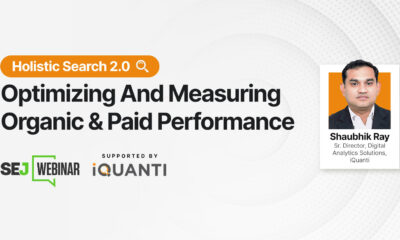SEO
7 Tips To Help Your Organization Get Found

Non-profit organizations can benefit greatly from exposure online.
SEO is a great way to gain organic traffic, regardless of the mission of the organization and the intent of the searcher.
Yes, there are opportunities through Google Ads grants and supporters to help drive traffic.
However, being found organically is a cost-effective and trusted way to gain long-term visibility and further the mission of a non-profit.
Most non-profits operate on lean budgets and have to be very judicious with their resources.
I have had the opportunity to work with many spanning focuses and missions aimed at healthcare, education, performing arts, adoption, orphanages, and more.
Within each non-profit, I have found tips that help regardless of most focuses and circumstances.
From solid funding to grassroots organizations, there’s a lot to be gained by focusing on seven SEO tips to help your organization get found.
1. Develop SEO Goals
I have personally heard from and witnessed non-profit organizations spend time somewhat aimlessly. I understand the fact that resources are limited and dollars potentially even more so.
That means it is even more important to have specific, realistic goals for what SEO could and should do for the organization. Disparate, scattered efforts that are working toward a specific goal are often wasted.
A lot of non-profits have specific stakeholder groups and different goals for each.
For example, I worked with a large national non-profit organization focused on a very specific disease.
Their audience included many audiences and potential visitors including those who were just diagnosed, scared, and seeking information.
Beyond that, they had goals for advocates, donors, those engaged in events, those interested in furthering legislation, and general supporters.
All had some level of awareness, engagement, and action goals layered on top.
With a large number of specific funnels, conversion actions, and stakeholder purposes for finding the org, engaging online, and getting to the ultimate goal, it is important to define specific goals and success metrics.
2. Create Funnels And Stakeholder Sections
Building on what I noted about the disparate stakeholders and types of goal actions, we can create paths for them and content within the website.
Non-profit sites can often be a mess. That’s not on purpose as it can be hard to work on all the content needed and to scale the website over time.
Survey your audience. Learn what they really want and what resources matter to them.
Tailor your content based on feedback and what you know about the cause.
Know that some people want to plug in a credit card quickly.
Others want to consume long-form content.
Even more might want to learn about events and ways to connect.
Give all of them their own path and custom journey.
My team is working currently with a large non-profit that funds a lot of worthy organizations and fosters entrepreneurship.
We have a laser focus on specific topics, content strategies, and investments to make sure that the right people are reached and that the org is positioned prominently for engagement compared to for-profit and other content sources.
3. Build Solid Infrastructure
This could have been number two, as it goes together with the funnel and stakeholder section building.
If you’re struggling with number two above, it could be because your site isn’t easy to manage.
Please note that all of the technical SEO needs are important for non-profits like they are in for-profit sectors.
On top of that, with the various funnels and goals, a solid UX and information architecture is critical.
We can’t lose people along the way or waste any precious impressions and clicks. We need sites that convince and convert users.
We have a story to tell and need it to be told without bounces and losing people along the way due to not finding the right content and spot for them on the site.
I saw firsthand how a local non-profit benefited from this type of approach.
As a tax levy, yet independent, a non-governmental non-profit that provided grants for mental health organizations, it had a lot of technical details to share.
The org had a very specific grantmaking process. That process could be hard to understand and follow.
The org spends a lot of time and focuses on awareness in SEO as well as Q&A.
Beyond that, it was important to share how taxpayer funds are used and how it serves the broader community.
All of those funnels, plus some for politicians curious are big reasons why the funnel and rich content model works so well.
4. Invest Carefully In Content
Content can be a big, open-ended question for non-profits.
There are a lot of really important things to say – both about the organization’s story and the voice it has in the cause.
Passions for blogging, creating resources, and telling the important story of the cause can drive a lot of great content.
At the same time, for some organizations writing can be put on the back burner when events, fundraising, and things central to the mission take the most time.
Content can be a big effort whether it is working or not and it might need more focus.
Or, it can be lacking and need more consistency and discipline.
Regardless, a sweet spot has to be found to fuel the areas of the funnel and focus that matter for organic search.
I can think of a great example who tells their story well and also serves as a leader as a resource of information.
They serve troubled youth and are an option for parents who are out of options for their high school kids.
They take in troubled youth from around the U.S. and have a high staff-to-student ratio serving them with love and highly skilled and accountable care.
Through their site, they share their research, expertise, and thought leadership in their space.
They also have an emotional and impactful story to share with prospective parents and students.
They do amazing work and serve a much-needed cause and do a great job of investing in content at the levels needed for those interested in stats and facts as well as they move others by resonating with their exact situation and emotions.
5. Leverage Partners For Links
In addition to technical and content aspects of SEO, non-profits need to also leverage off-page factors.
A big part of that is backlinks.
That means ensuring that all partners, advocates, and associates are helping the cause wherever they can by linking to the non-profit website.
Through natural links tied to relationships, I’m not talking about spammy or unnatural links.
If an aligned partner or organization is supporting the cause, simply make sure that they know where to link for the best possible user experience and to cue the search engines to that association.
Beyond that, any opportunities for outreach and network growth should also be considered.
Link research into comparable organizations should be done. This can help with development efforts as well as outreach to develop more partners.
An example of a non-profit organization gaining SEO benefits from backlinks is a flagship performing arts center.
As a venue, it has several resident organizations or other non-profits who call it home for their concerts and performances.
Beyond that, corporate sponsors, civic organizations, artists, ticketing sites, and more all naturally link to the center.
Leveraging all of the specific partners and relationships, the performing arts center fully leverages the value of the links and “votes” from those other sites to benefit their own.
6. Smartly Use Social
Social media has been one of the most debated things in terms of its impact on SEO. I’m not here to foster that debate in this article.
However, I can say that I ascribe to at least the correlation between social media activity and better SEO performance.
Again, not here for a debate.
If you can get on board with at least correlation (not causation), then please factor in your social media activity with your search strategy.
Look at the content you want to get ranked well and get links to.
Build your social strategy around that.
Get your own social accounts to link to it and get other people to share and link to it.
A national organization that I work with that is an association of intercollegiate athletics does a great job of this.
They leverage their investments in the content to get as much mileage as possible.
That means creating the content once and publishing it on the site and promoting it via Google Ads, social, email, and all possible channels.
Ultimately, they want organic search as well and know that as much engagement, links, and references they can get to their data, research info, and recruiting info they can get, the better it will perform organically. And, it does!
7. Plan, Measure, & Repeat
I can point to a number of great examples of non-profits owning organic search results and seeing real results from them. Most have a well-defined and intentional plan and effort in place.
It isn’t about trying harder.
It is about specific focus and knowing that there’s ROI or real, measurable impact that can come from organic search.
In so many of those successful cases, there’s planned action and tactics.
That means a regular and consistent effort in technical SEO factors, content, and knowing that SEO includes the word “optimization.”
It isn’t a one-time thing or a quick strategy.
It takes definition, planning, resources, and sticking with it.
You don’t have competitors in the traditional sense, but you do when it comes to gaining impressions and visitors and people talking about the content that you so deservedly want and need.
Wrap Up
You have a great cause and organization.
Your mission means a lot to a lot of people.
Don’t short-change it or miss out on your chance to gain visitors who have a range of interests, goals, and reasons they should come to your site.
Use these seven tips for non-profit SEO and get the most out of your resources and continue driving your mission forward.
More Resources:
Featured Image: Drazen Zigic/Shutterstock







![How to Create A Website to Sell Products In 8 Steps [+6 Expert Tips] How to Create A Website to Sell Products In 8 Steps [+6 Expert Tips]](https://articles.entireweb.com/wp-content/uploads/2024/10/1727868370_How-to-Create-A-Website-to-Sell-Products-In-8.webp-400x240.webp)
![How to Create A Website to Sell Products In 8 Steps [+6 Expert Tips] How to Create A Website to Sell Products In 8 Steps [+6 Expert Tips]](https://articles.entireweb.com/wp-content/uploads/2024/10/1727868370_How-to-Create-A-Website-to-Sell-Products-In-8.webp-80x80.webp)










You must be logged in to post a comment Login